Last-Minute NYC Holiday Gift Guide 🎁
We’ve created a holiday gift guide with presents for the intrepid New Yorker that should arrive just in time—


With hip restaurants, dimly lit bars, artisan boutiques, street art murals, and soaring real estate prices, Williamsburg might be Brooklyn’s trendiest neighborhood. Like it or not, it’s the neighborhood that defines Brooklyn’s international reputation. Of course, it wasn’t always that way — Williamsburg has evolved many times over the course of its 300+ year history.
Brooklyn — or Breuckelen, as it was originally known — was first settled in 1636 by Dutch farmers, who eventually spread to Bushwick and Williamsburg in 1660. Brooklyn was originally incorporated as its own city in 1834 and in 1855, Bushwick and Williamsburg were annexed to it. It didn’t become a borough of New York City until 1898.
For much of the 20th century, Williamsburg was a working class neighborhood, initially populated by immigrants who fled the tenements of the Lower East Side after the Williamsburg Bridge was built. Factories producing everything from sugar to glassware lined the waterfront, and some of their vestiges have been transformed into hip hotels, apartment complexes, and parks. When industrial production declined in the 1960s, the neighborhood did too — until the late ’90s, when artists and other creatives priced out of Soho started moving here and catalyzed a renaissance.
Even if you think you know everything about Williamsburg, you might be surprised by some of the hidden history and quirky places we dug up. From the inspiration for the Williamsburg Bridge to the location of the world’s smallest cinema, here are 10 fascinating secrets about Williamsburg.
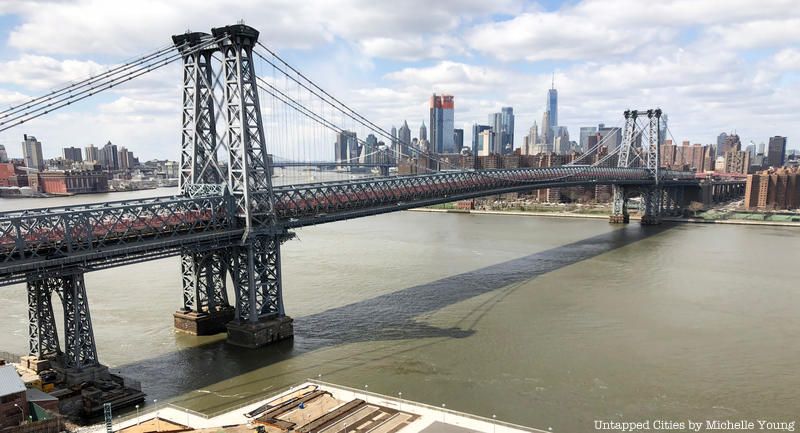
The Williamsburg Bridge may be considered one of the city’s ugliest bridges, but its chief engineer Leffert Buck may have been inspired by the Eiffel Tower. Indeed, he had previously worked with Gustav Eiffel, which may account for the similarities between the bridge and Paris’s famous tower. To be fair, the Eiffel Tower wasn’t particularly well received either when it first opened.
When the bridge opened in 1903, it was the longest suspension bridge in the world. Leffert chose to use steel because it was lighter and stronger than stone and the construction process was much simpler. It took half as long to build the Williamsburg Bridge as it took to build the Brooklyn Bridge (seven years versus 13). When it first opened, it became known as the “Jews’ Highway” because so many Jewish immigrants fled the Lower East Side‘s tenements, changing the ethnic makeup of the neighborhood, which until then was mostly German and Irish.
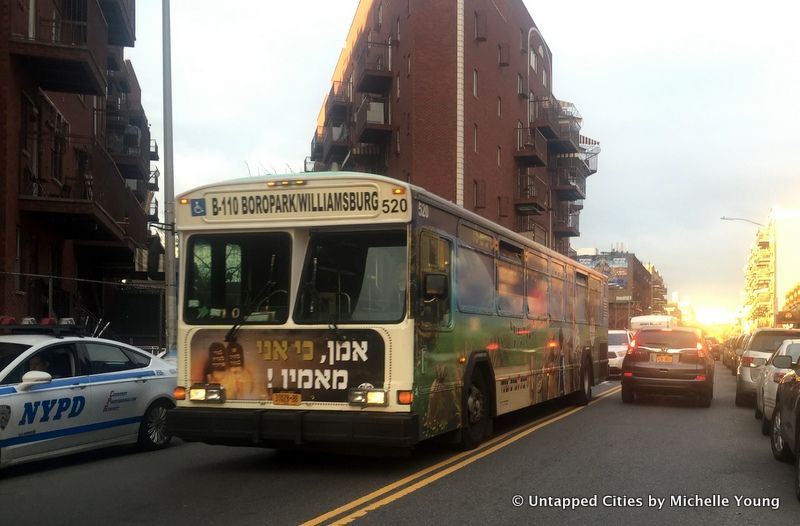
Have you ever noticed the B-110 bus covered in Yiddish writing driving the streets of South Williamsburg? It serves the insular Hasidic Jewish community, connecting Williamsburg to Borough Park, a Jewish stronghold in South Brooklyn. Technically anyone can take it., but its route doesn’t appear on any MTA maps and it costs more to ride than a normal MTA bus. In the past, it attracted controversy for instructing women to sit at the back, separate from the men.
Not only does the Hasidic community have their own bus, but they also have their own ambulance squad called Chevra Hatzalah. Founded in Williamsburg in 1965, the volunteer, all male squad claims that its mission is to help anybody with a medical emergency, Jewish or not. But because of the community’s insularity and conservative beliefs, the service is mostly used by Hasidic Jews who don’t want to be touched by EMTs outside of their community. According to the City, Hasidic women — raised with modesty as a core value — have been battling for an ambulance for their all female squad to help the women in their community, but have received opposition from Hatzalah.
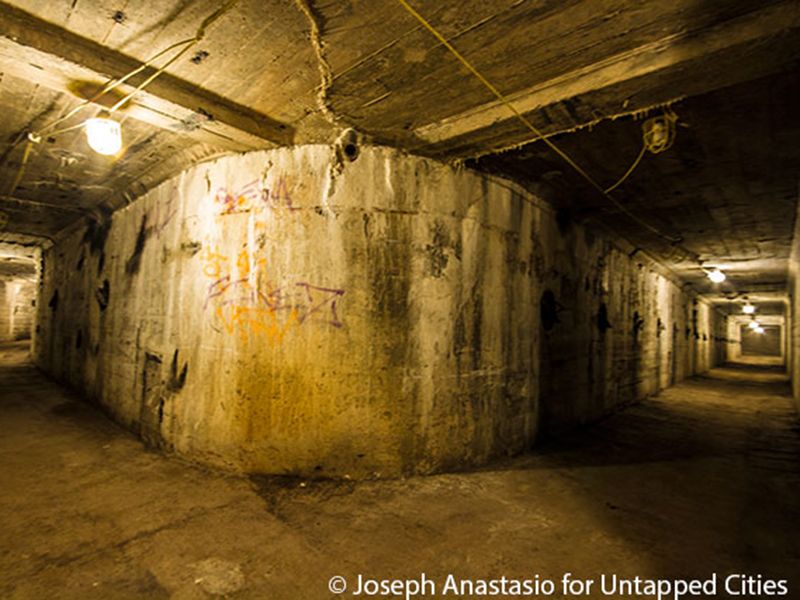
Designated as a historic landmark, the McCarren Park Pool was created by Robert Moses in 1936 as one of 11 public pools made with funding from the Works Progress Administration. Opened in a record-breaking heatwave, the pool was meant to alleviate poor health conditions and provide recreational space in the predominantly working-class neighborhood. It measured 330 by 165 feet and could accommodate 6,800 swimmers at a time. It had the largest bathhouse of all 11 pools and its design was inspired by the ancient Baths of Caracalla in Rome.
To support the filtration systems, heating units, and underwater lighting, a series of tunnels were built under the perimeter of the pool. They connected the boiler room under the entrance to the filtration plant in the rear. The pool fell into disrepair in the 1980s and was abandoned until 2005, when a series of concerts and dance performances in the empty pool renewed public interest, leading to its designation as a historic landmark and eventual renovation.
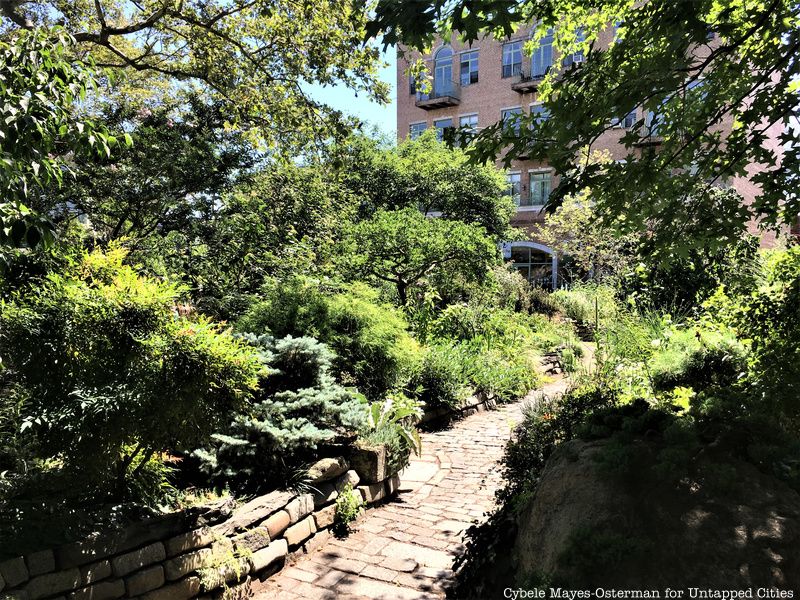
Tucked away behind the track in McCarren Park is a verdant oasis known as the Green Dome Community Garden. At just 2,500 square-feet, the small garden provides a peaceful place for people to get some fresh air in part of a “quiet zone” on N 12th Street between Union and Driggs Avenues. Volunteers from the community maintain the garden and the plants. The garden has a no pesticide policy, which encourages bird and insect life.
Over the years, the garden has been landscaped with Belgian block paths, two mounds for children to climb, boulders, and masonry collected from the neighborhood. The next time you’re in the area and looking for a quiet place to sit, check it out. It’s open everyday from 10 a.m. until dusk.

One of the coolest museums in New York City, the City Reliquary started in 2002 as makeshift museum in the window of Dave Herman’s Williamsburg apartment. Thanks to donations from patrons, it moved into its current home on Metropolitan Avenue in 2006 and has remained a not-for-profit community museum ever since.
The small space is filled chock-a-block with New York ephemera and artifacts, including old subway tokens (remember those?), Statue of Liberty postcards, fragments of terracotta from landmark buildings, and antique seltzer bottles. It’s well worth a visit for its permanent collection, but also hosts rotating exhibits, which in the past have covered everything from New York’s old school donut shops to the city’s most innovative instrument makers.
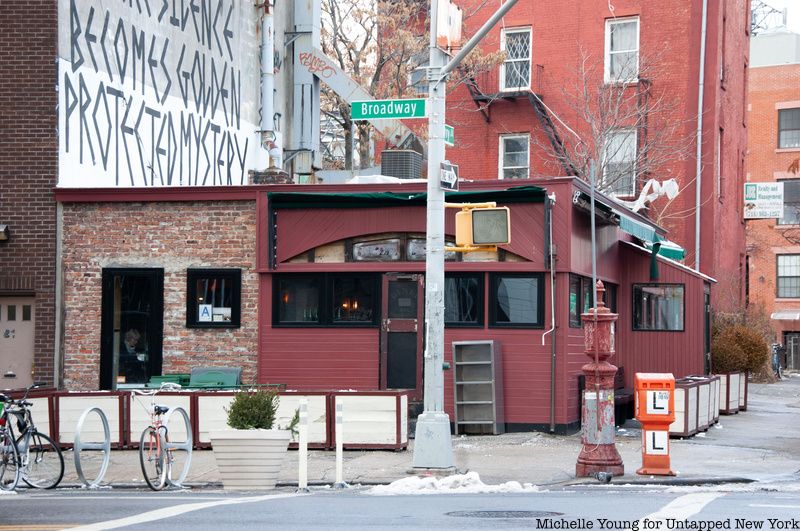
Now Williamsburg is a destination for drinking and dining, but when Andrew Tarlow opened Diner in 1999, the neighborhood was a culinary wasteland. At the time, he and his business partner Mark Firth were living in a 6,000-square-foot loft in Williamsburg and working at the Odeon in Tribeca. They convinced their landlord to buy the 1927 dining car under the Williamsburg bridge and rent it to them. They then renovated the space themselves and opened on New Year’s Eve 1998 with a cassoulet by the restaurant’s first chef Caroline Fidanza, who has been called “one of the most quietly influential figures in the history of Brooklyn restaurants” by T Magazine.
That first dinner set the tone for what the restaurant would serve: elevated home-style cooking prepared with fanatically sourced local ingredients. It also became a blueprint that restaurants in Williamsburg and beyond would copy to the point of becoming cliché.
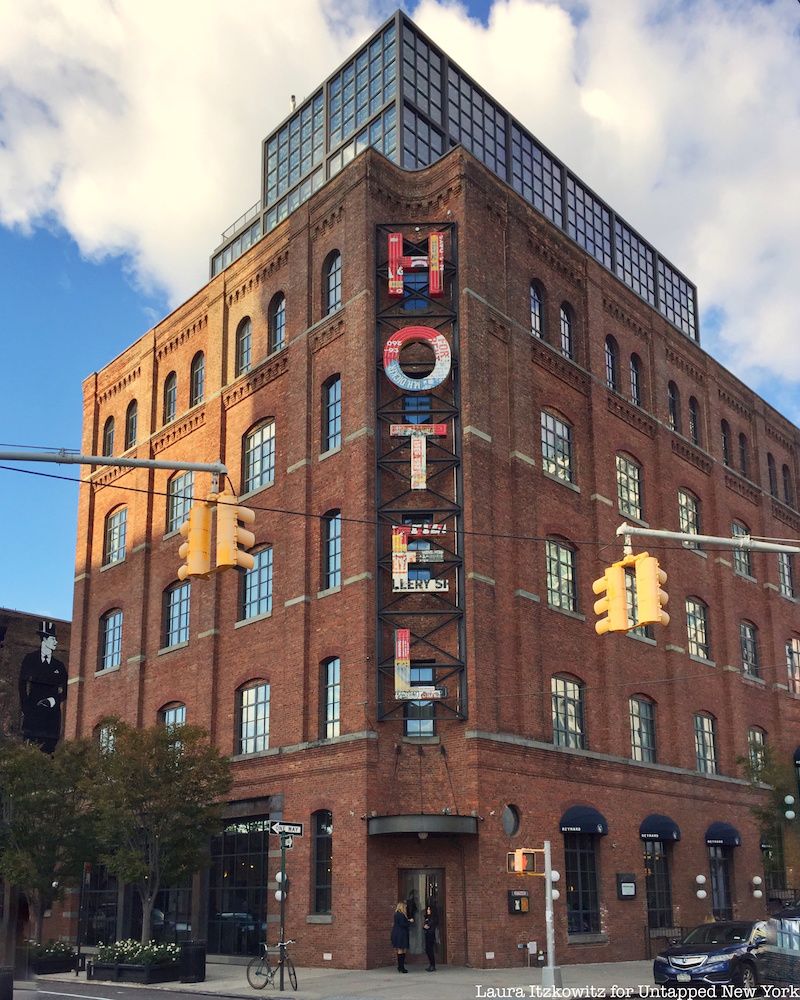
The Wythe Hotel — Williamsburg’s first hotel — opened in 2012 in a former cooperage on the waterfront and from the beginning it has celebrated the community of artists that has populated the area since the ’90s and early aughts. The iconic ‘Hotel’ sign on the building’s façade was made by local artist Tom Fruin, who’s best known for his colorful glass houses that glow from within. Enter the lobby and you’ll see a large-scale drawing by Duke Riley depicting historical elements of Williamsburg. Steve ESPO Powers contributed some murals on the hotel’s brick walls.
And that’s just the beginning — the Wythe Hotel’s art collection encompasses pieces by 60 artists, including hundreds of works on paper. Most of the works are displayed in the rooms for guests to enjoy, but there are also rotating exhibitions in the lobby and art in other public spaces, even the bathrooms. Join us for a virtual tour of the collection with the hotel’s art curator, Kimia Ferdowsi Kline, on December 8, 2021 at 12 p.m. The event is free for Untapped New York Insiders.
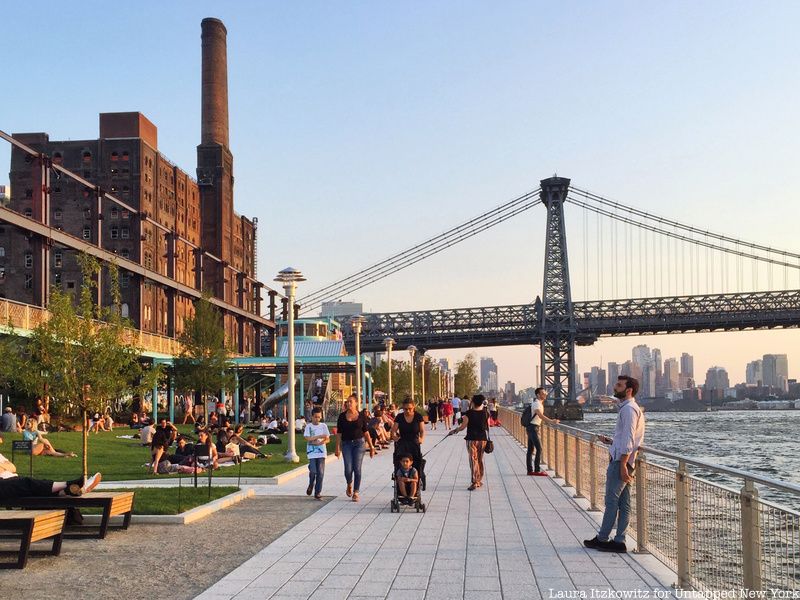
The Wythe Hotel isn’t the only example of a former factory being transformed — Domino Park and the surrounding complex of condos, retail shops, and restaurants was once the Domino Sugar Refinery. Opened in 1856, it was once the world’s largest and most productive sugar refinery, at one point producing up to 98% of the sugar consumed in the United States. Though industrial production in Williamsburg began declining in the 1950s and ’60s, the Domino Sugar Refinery held out as the last major active industrial operation on the waterfront. It finally closed in 2004 and sat abandoned for 14 years.
Domino Park opened in 2018 as part of a massive real estate development by Two Trees Management, who hired James Corner Field Operations (one of the landscape designers behind the High Line in the Meatpacking District and Chelsea) to create a privately owned publicly accessible park that would restore waterfront access to New Yorkers. The park incorporates industrial relics of the Domino Sugar Refinery, including teal gantry cranes, 21 original columns from the sugar warehouse, seating steps made with wood reclaimed from the refinery, and old syrup tanks.
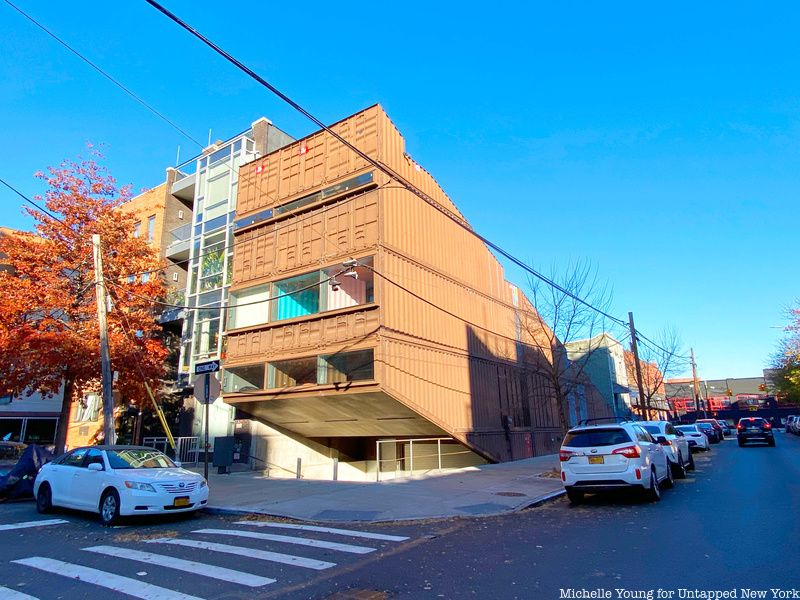
According to the New York Post, a green home made entirely of 21 shipping containers sold for $5 million. Completed in 2016, the 5,000-square-foot, five-bedroom home was designed by LOT-EK and commissioned by Joe and Kim Carroll, who own popular neighborhood spots Anselm and Spuyten Duyvil. “The house was created by stacking 21 shipping containers on top of each other, and cutting them diagonally along the top and the bottom—this in turn has created outdoor space on every level of the house,” Curbed reported.
Surprisingly, the home isn’t the first shipping container house in Williamsburg. In 2013, we reported on a Williamsburg home made with six shipping containers. Each container was purchased at $1,500 and insulated with NASA ceramic-infused paint. According to the home’s owner, David, Boyle, he chose to build with shipping containers because “it was cheaper.” We suspect that wasn’t the primary motivation of the Carrolls.
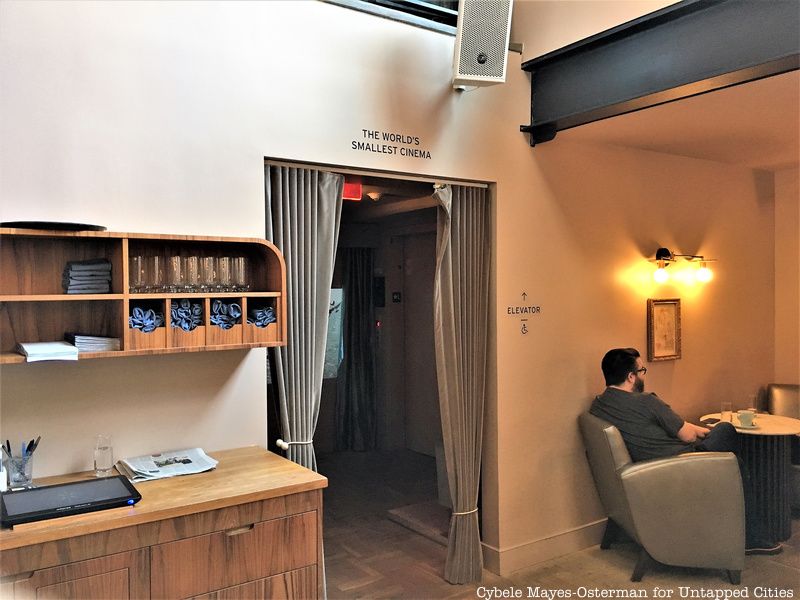
The Hoxton Williamsburg, which opened in 2018, was the first stateside hotel by British micro-hotels brand the Hoxton. It gained much attention for its cool, vintage-inspired design and rooftop bar Summerly, but the hotel also has a little-known secret. Tucked away off the lobby is the self-proclaimed world’s smallest cinema.
The tiny room has two folding cinema-style seats and headphones for listening to the films, which are projected onto the wall and played 24/7. The hotel changes the featured film every month, with past screenings including Jaws and The Birdcage starring Robin Williams. No need to be a hotel guest to watch a film — the world’s smallest cinema is free and open to anyone. Just draw the velvet curtains closed to block out the light from the lobby and enjoy the film.
Next, read 10 fun facts about Williamsburg, Brooklyn’s early history!
Subscribe to our newsletter